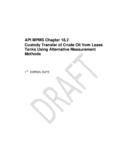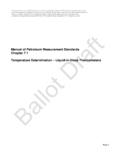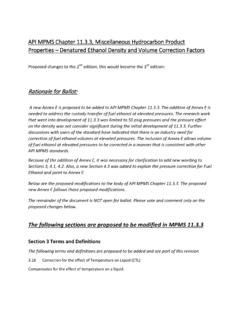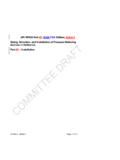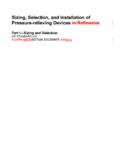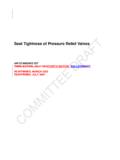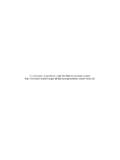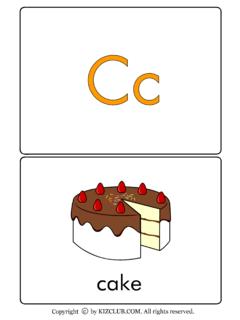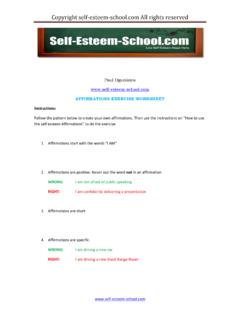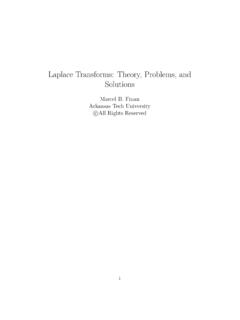Transcription of jurisdiction. Copyright API/EI. All rights reserved API …
1 This document is not an API/EI Standard; it is under consideration within an API and EI technical committee but has not received all approvals required to become an API/EI Standard. It shall not be reproduced or circulated or quoted, in whole or in part, outside of API/EI committee activities except with the approval of the Chairman of the committee having jurisdiction. Copyright API/EI. all rights reserved API CHAPTER 17, SECTION 9/IP HM 49 VESSEL EXPERIENCE FACTOR 1 API Manual of Petroleum Measurement Standards Chapter 17 Marine Measurement Section 9 Vessel Experience Factor (VEF) EIIP Hydrocarbon Management HM 49 FIRST EDITION, NOVEMBER 2005 Published jointly by American Petroleum Institute and Energy Institute, London The Energy Institute is a professional membership body incorporated by Royal Charter 2003 Registered charity number 1097899 This document is not an API/EI Standard.
2 It is under consideration within an API and EI technical committee but has not received all approvals required to become an API/EI Standard. It shall not be reproduced or circulated or quoted, in whole or in part, outside of API/EI committee activities except with the approval of the Chairman of the committee having jurisdiction. Copyright API/EI. all rights reserved API CHAPTER 17, SECTION 9/IP HM 49 VESSEL EXPERIENCE FACTOR 2 FOREWORD This publication was prepared jointly by the American Petroleum Institute Committee on Petroleum Measurement and the Energy Institute Hydrocarbon Management Committee.
3 Nothing contained in any API/EIIP joint publication is to be construed as granting any right, by implication or otherwise, for the manufacture, sale, or use of any method, apparatus, or product covered by letters patent. Neither should anything contained in the publication be construed as insuring anyone against liability for infringement of letters document was produced under API standardization procedures that ensure appropriate notification and participation in the developmental process and is designated as an API standard. Questions concerning the interpretation of the content of this publication or comments and questions concerning the procedures under which this publication was developed should be directed in writing to the Director of Standards, American Petroleum Institute, 1220 L Street, , Washington, 20005.
4 Requests for permission to reproduce or translate all or any part of the material published herein should also be addressed to the director. Generally, API standards are reviewed and revised, reaffirmed, or withdrawn at least every five years. A one-time extension of up to two years may be added to this review cycle. Status of the publication can be ascertained from the API Standards Department, telephone (202) 682-8000. A catalog of API publications and materials is published annually and updated quarterly by API, 1220 L Street, , Washington, 20005. Suggested revisions are invited and should be submitted to the Standards and Publications Department, API, 1220 L Street, NW, Washington, DC 20005, USA, e-mail: or the Technical Department, Energy Institute, 61 New Cavendish Street, London, W1G 7AR, Energy Institute's Hydrocarbon Management Committee is responsible for the production and maintenance of standards and guides covering various aspects of static and dynamic measurement of petroleum.
5 The Committee, its sub-committees and work groups are made up of experts representing oil companies, equipment manufacturers, service companies and terminal and ship owners and operators. The Committee has encouraged international participation for many years and when producing documents its aim is to represent the best consensus of international technical expertise and practice. This is particularly the case here and is the main reason behind the production of joint documents involving cooperation with experts from the API. The IP Hydrocarbon Management Guides are recommended for general adoption but should be read and interpreted in conjunction with weights and measures, safety, customs and excise and other regulations in force in a particular country in which they are to be applied.
6 Such regulatory requirements have precedence over corresponding clauses in the IP's documents except where the requirements of the latter are more rigorous, when its use is recommended. A full list of the IP Hydrocarbon Management Guides is available on request from the Energy Institute. This document is not an API/EI Standard; it is under consideration within an API and EI technical committee but has not received all approvals required to become an API/EI Standard. It shall not be reproduced or circulated or quoted, in whole or in part, outside of API/EI committee activities except with the approval of the Chairman of the committee having jurisdiction. Copyright API/EI. all rights reserved API CHAPTER 17, SECTION 9/IP HM 49 VESSEL EXPERIENCE FACTOR 3 Manual of Petroleum Measurement Standards Chapter 17 Marine Measurement Section 9 Vessel Experience Factor (VEF) IP EIHydrocarbon Management HM 49 Vessel Experience Factor (VEF) 0 Introduction For any given vessel, a ratio can be established between the quantity of liquid bulk cargoes measured on board the vessel and the corresponding measurement by a load or discharge facility.
7 This ratio, called a Vessel Experience Factor (VEF) is a historical compilation of shore-to-vessel or vessel-to-shore cargo quantity differences and is used as a loss control tool to assess the validity of quantities derived from shore measurements. When agreed by interested parties, Bill of Lading or Outturn quantities may be determined based on vessel received or delivered quantities adjusted by the VEF, in cases where shore based measurements are not available, or are known to be inadequate for custody transfer. In the event of a dispute regarding the application of a VEF, resolution shall be made by the commercial parties involved. Vessel capacity tables are often calculated from the vessel s building plans, rather than based on accurate physical tank calibration measurements.
8 There are usually differences between the quantity of a cargo measured in a calibrated shore tank or by a custody transfer meter, and the same cargo determined by vessel tank measurements. For a given vessel the use of quantity data from many voyages provides an indication of vessel measurement differences, as a numerical ratio. This ratio can also include other load and discharge factors. For each voyage a Vessel Load Ratio (VLR) and Vessel Discharge Ratio (VDR) can be calculated. The VLR or VDR is the quantity received or discharged as measured on the vessel (TCV - ROB or OBQ) divided by the Bill of Lading (shore delivered at loading) or Outturn Quantity (shore received at discharge) respectively. The mean of the qualifying VLRs or the VDRs over several voyages is called the VEF (VEFL and VEFD for load and discharge respectively.)
9 This standard provides a method for calculating VEF. The method uses an average of qualifying ratios, which fall within +/- % of the mean. Certain voyages, including those considered to contain Gross Errors will be excluded from the mean calculation, as described in Section 8 of this standard. This method is preferred and should be used unless all parties specifically agree to an alternate method. See Appendix D for an alternate method employing a statistical outlier rejection technique to discard unsatisfactory data. This document was developed by a joint American Petroleum Institute and Energy Institute Hydrocarbon Management Working Group. 1 Scope This standard provides a recommended practice for the calculation and application of a VEF and provides guidelines for data compilation, data validation, and recommendations on the appropriate use of VEF during custody transfer involving marine tank vessels.
10 It also provides clear guidance on maintenance of quantity data on board the vessel, calculation of VEFs and application of VEFs. The key aim is to provide a single unambiguous figure for VEFL or VEFD and to remove the possibility of any arbitrary inclusion or exclusion of data on the part of the individual(s) performing the final calculation. Close attention has been paid to the calculation method which has been tested using historical data. Bearing in mind the uncertainty which will attach to any individual measurement (including those being corrected using the VEF figure) the calculation method will provide a stable and robust ratio. This document is not an API/EI Standard; it is under consideration within an API and EI technical committee but has not received all approvals required to become an API/EI Standard.
